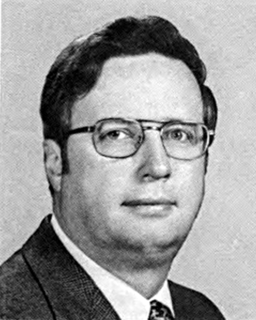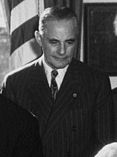
William Warren Scranton was an American Republican Party politician and diplomat. Scranton served as the 38th Governor of Pennsylvania from 1963 to 1967.

The Pennsylvania gubernatorial election of 2006 was held on November 7, 2006 and included the races for the Governor of Pennsylvania and Lieutenant Governor of Pennsylvania.

William H. Milliken Jr. was an American politician from Pennsylvania who served as a Republican member of the U.S. House of Representatives for Pennsylvania's 7th congressional district from 1959 to 1965. He served in the Pennsylvania House of Representatives for Delaware County from 1943 to 1946 and from 1949 to 1950.

The Pennsylvania gubernatorial election of 2002 was held on November 5, 2002, and included the races for the governor and lieutenant governor of Pennsylvania. Incumbent Republican Governor Mark Schweiker, who became Governor in 2001 when Tom Ridge resigned to become Homeland Security Advisor, was eligible to run for a full term, but did not do so. Democrat Ed Rendell, the former Mayor of Philadelphia and Chairman of the Democratic National Committee, emerged from a competitive primary to win the general election against Republican Pennsylvania Attorney General Mike Fisher.

The Pennsylvania gubernatorial election of 1994 was held on November 8, 1994. The incumbent governor, Bob Casey, Sr. (Democrat), was barred from seeking a third term by the state constitution. The Republican Party nominated Congressman Tom Ridge, while the Democrats nominated Mark Singel, Casey's lieutenant governor. Ridge went on to win the race with 45% of the vote. Singel finished with 39%, and Constitution Party candidate Peg Luksik finished third, garnering 12% of the vote.

The 1998 United States Senate election in Pennsylvania was held November 3, 1998. Incumbent Republican U.S. Senator Arlen Specter won re-election to a fourth term.

The Pennsylvania Gubernatorial election of 1990 was held on November 6, 1990. Incumbent Democratic Robert P. Casey easily defeated Republican Barbara Hafer. Governor Casey defeated Ms. Hafer by a margin of 35.29%, and carried 66 out of 67 Pennsylvania counties.

The Pennsylvania Gubernatorial election of 1986 was held on November 4, 1986. Democrat Bob Casey narrowly defeated Republican Bill Scranton III, in a race that featured two very high-profile candidates.

The Pennsylvania gubernatorial election of 1982 was held on November 2, 1982 between incumbent Republican Dick Thornburgh and Democratic U.S. Congressman Allen E. Ertel.

The Pennsylvania gubernatorial election of 1978 was held on November 7, 1978 between Republican Dick Thornburgh and Democrat Pete Flaherty.

The Pennsylvania gubernatorial election of 1974 was held on November 5. Incumbent Democratic Governor Milton Shapp defeated Republican Drew Lewis. Under the state's 1968 constitution, Shapp was the first governor who was eligible to run for consecutive terms.

The Pennsylvania gubernatorial election of 1970 was held on November 3. Democrat Milton Shapp challenged incumbent Republican Lieutenant Governor Ray Broderick.

The Pennsylvania gubernatorial election of 1966 was held on November 8. Republican Ray Shafer, the state's incumbent Lieutenant Governor, was elected to the state's highest office after holding off a charge from future governor Milton Shapp.

The Pennsylvania gubernatorial election of 1954 was held on November 2. In what is considered a crucial realigning election for the state, Democratic State Senator George Leader defeated Republican incumbent Lieutenant Governor Lloyd Wood by a surprisingly large margin.

The Pennsylvania gubernatorial election of 1950 was held on November 7. For the twenty-second time in twenty-five elections, the Republican candidate was victorious, but by a much smaller than usual margin. Superior Court Judge John S. Fine defeated Democrat Richardson Dilworth, the City Controller of Philadelphia.

Philadelphia's municipal election held on November 6, 1951, was the first under the city's new charter, which had been approved by the voters in April, and the first Democratic victory in the city in more than a half-century. The positions contested were those of mayor and district attorney, and all seventeen city council seats. There was also a referendum on whether to consolidate the city and county governments. Citywide, the Democrats took majorities of over 100,000 votes, breaking a 67-year Republican hold on city government. Joseph S. Clark Jr. and Richardson Dilworth, two of the main movers for the charter reform, were elected mayor and district attorney, respectively. Led by local party chairman James A. Finnegan, the Democrats also took fourteen of seventeen city council seats, and all of the citywide offices on the ballot. A referendum on city-county consolidation passed by a wide margin. The election marked the beginning of Democratic dominance of Philadelphia city politics, which continues today.

Philadelphia's municipal election of November 8, 1955, involved contests for mayor, district attorney, all seventeen city council seats, among other offices. Citywide, the Democrats took majorities of over 130,000 votes, continuing their success from the elections four years earlier. Richardson Dilworth, who had been elected district attorney in 1951, was elected mayor. Victor H. Blanc, a city councilman, was elected district attorney. The Democrats also kept fourteen of seventeen city council seats, losing one district seat while gaining another, and kept control of the other citywide offices. The election represented a further consolidation of control by the Democrats after their citywide victories of four years earlier.

Philadelphia's municipal election of November 3, 1959 involved contests for mayor, all seventeen city council seats, and several other executive and judicial offices. Citywide, the Democrats took majorities of over 200,000 votes, continuing their success from the elections four years earlier. Richardson Dilworth, who had been elected mayor in 1955, was re-elected over Republican nominee Harold Stassen. The Democrats also took fifteen of seventeen city council seats, the most seats allowed to any one party under the 1951 city charter. They further kept control of the other citywide offices. The election represented a continued consolidation of control by the Democrats after their citywide victories of the previous eight years.

Philadelphia's municipal election of November 7, 1961, involved the election of the district attorney, city controller, and several judgeships. Democrats swept all of the city races but saw their vote totals much reduced from those of four years earlier, owing to a growing graft scandal in city government. District Attorney James C. Crumlish, Jr. and City Controller Alexander Hemphill, both incumbents, were returned to office. Several ballot questions were also approved, including one permitting limited sales of alcohol on Sundays.



























